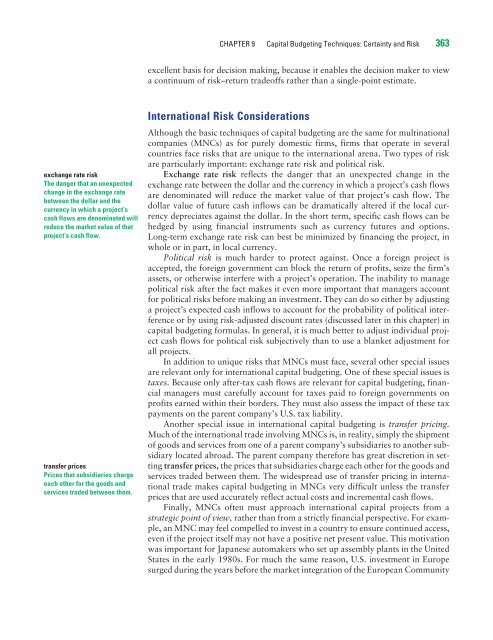Capital Budgeting Techniques: Certainty and Risk
Capital Budgeting Techniques: Certainty and Risk
Capital Budgeting Techniques: Certainty and Risk
You also want an ePaper? Increase the reach of your titles
YUMPU automatically turns print PDFs into web optimized ePapers that Google loves.
exchange rate risk<br />
The danger that an unexpected<br />
change in the exchange rate<br />
between the dollar <strong>and</strong> the<br />
currency in which a project’s<br />
cash flows are denominated will<br />
reduce the market value of that<br />
project’s cash flow.<br />
transfer prices<br />
Prices that subsidiaries charge<br />
each other for the goods <strong>and</strong><br />
services traded between them.<br />
CHAPTER 9 <strong>Capital</strong> <strong>Budgeting</strong> <strong>Techniques</strong>: <strong>Certainty</strong> <strong>and</strong> <strong>Risk</strong> 363<br />
excellent basis for decision making, because it enables the decision maker to view<br />
a continuum of risk–return tradeoffs rather than a single-point estimate.<br />
International <strong>Risk</strong> Considerations<br />
Although the basic techniques of capital budgeting are the same for multinational<br />
companies (MNCs) as for purely domestic firms, firms that operate in several<br />
countries face risks that are unique to the international arena. Two types of risk<br />
are particularly important: exchange rate risk <strong>and</strong> political risk.<br />
Exchange rate risk reflects the danger that an unexpected change in the<br />
exchange rate between the dollar <strong>and</strong> the currency in which a project’s cash flows<br />
are denominated will reduce the market value of that project’s cash flow. The<br />
dollar value of future cash inflows can be dramatically altered if the local currency<br />
depreciates against the dollar. In the short term, specific cash flows can be<br />
hedged by using financial instruments such as currency futures <strong>and</strong> options.<br />
Long-term exchange rate risk can best be minimized by financing the project, in<br />
whole or in part, in local currency.<br />
Political risk is much harder to protect against. Once a foreign project is<br />
accepted, the foreign government can block the return of profits, seize the firm’s<br />
assets, or otherwise interfere with a project’s operation. The inability to manage<br />
political risk after the fact makes it even more important that managers account<br />
for political risks before making an investment. They can do so either by adjusting<br />
a project’s expected cash inflows to account for the probability of political interference<br />
or by using risk-adjusted discount rates (discussed later in this chapter) in<br />
capital budgeting formulas. In general, it is much better to adjust individual project<br />
cash flows for political risk subjectively than to use a blanket adjustment for<br />
all projects.<br />
In addition to unique risks that MNCs must face, several other special issues<br />
are relevant only for international capital budgeting. One of these special issues is<br />
taxes. Because only after-tax cash flows are relevant for capital budgeting, financial<br />
managers must carefully account for taxes paid to foreign governments on<br />
profits earned within their borders. They must also assess the impact of these tax<br />
payments on the parent company’s U.S. tax liability.<br />
Another special issue in international capital budgeting is transfer pricing.<br />
Much of the international trade involving MNCs is, in reality, simply the shipment<br />
of goods <strong>and</strong> services from one of a parent company’s subsidiaries to another subsidiary<br />
located abroad. The parent company therefore has great discretion in setting<br />
transfer prices, the prices that subsidiaries charge each other for the goods <strong>and</strong><br />
services traded between them. The widespread use of transfer pricing in international<br />
trade makes capital budgeting in MNCs very difficult unless the transfer<br />
prices that are used accurately reflect actual costs <strong>and</strong> incremental cash flows.<br />
Finally, MNCs often must approach international capital projects from a<br />
strategic point of view, rather than from a strictly financial perspective. For example,<br />
an MNC may feel compelled to invest in a country to ensure continued access,<br />
even if the project itself may not have a positive net present value. This motivation<br />
was important for Japanese automakers who set up assembly plants in the United<br />
States in the early 1980s. For much the same reason, U.S. investment in Europe<br />
surged during the years before the market integration of the European Community

















